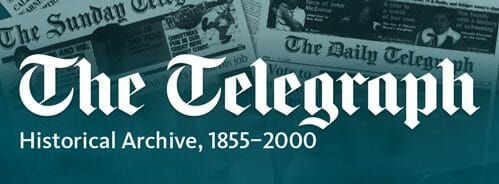We are celebrating the release of The Telegraph Historical Archive, 1855-2000 this week with a list designed to help you decide if you should look into this brand new resource.
You may not want to miss this historical never-before-digitised collection if…
8. You like Winston Churchill (at least a little)
Winston Churchill had his Telegraph writing debut with a series of war reports from what is now Pakistan (and which young Churchill does not recommend ‘as a resting-place for either the sybarite, the invalid, or the artist’); the first, ‘On the Indian Frontier,’ was published 6 October 1897.
Churchill wrote to and for the Telegraph throughout his long career, with his most historically significant contribution coming in 1938—a series of articles on British foreign policy and international affairs.
(Want to read more about Winston Churchill & the Telegraph? Read the full essay here.)
7. You are not a big fan of German Chancellor Kaiser Wilhelm
The Telegraph had a rocky relationship with Germany through the first half of the twentieth century; in 1934, the reporting of the Night of the Long Knives saw the paper banned in Germany on 10-11 July and again from 14-27 July 1934 (and yet again later in the 1930s).
Perhaps most famously, however, the Telegraph published an infamous uncensored interview with the German Chancellor on 28 October 1908. This interview raised diplomatic eyebrows with such statements as ‘You English…are mad, mad, mad as March hares’ and implications that France and Russia had tried to persuade Germany to enter the Boer War against the British. This was not a good look for the Chancellor.
6. Fun celebrity journalists intrigue you
The Telegraph employed many characters – to put it politely — as special correspondents over the years. Perhaps most notorious was George Augustus Sala, the first ‘celebrity’ journalist of the nineteenth century. His reporting, most notably during the American Civil War, was characterised by flamboyant expenses and extensive drama.
Honorable mention for personable and exciting correspondent goes to Ellis Ashmead-Bartlett, who particularly upset the British Government by reporting on the arrest of Mahatma Gandhi (you can read more about Mr Ashmead-Bartlett here).
5. You like crossword puzzles (and/or feature films)
Not only was The Telegraph the first to publish a daily crossword on 30 July 1925, they have a history of controversial, newsworthy, and accidentally-concerning puzzles. The most famous of these, of course, was featured in feature film The Imitation Game – solve it in under 12 minutes, and – surprise — you could be recruited to Bletchley Park to crack German codes.
In May 1944, several answers connected with D-Day landings appeared in the crossword, leading MI6 to question setter Leonard Dawe, who managed to convince the authorities it was a coincidence (read more about this in The Story of the Daily Telegraph).
4. Unique & exclusive war reporting from names like Clare Hollingworth, the first female war correspondent, piques your interest
On 29 August 1939, Clare Hollingworth was the first to relay the start of the Second World War with headline ‘1,000 Tanks Massed on Polish Frontier.’ Last October, this redoubtable journalist, still considered one of the best reporters of the twentieth century, turned 104.
3. Murder-solving, ghost stories, and special reports on real-life crimes by the incomparable Sir Arthur Conan Doyle are your cup of tea
With a heritage that began in July 1881 with pioneering the use of artists’ impressions to assist police to capture felons—helping to secure the arrest of Percy Lefroy Mapleton, the ‘Brighton Railway Murderer’—what makes more sense than continuing the tradition with the inclusion of ghost stories and Arthur Conan Doyle special reports?
2. You dream of exploring Africa and Mount Everest
In 1874, the Telegraph co-sponsored Henry Morton Stanley’s African expedition with the New York Herald. His many reports home are filled with excuses (‘A feeling of lassitude and ennui which has succeeded the return to Zanzibar from our exploration of the Rufiji is inimical to physical exertion or mental thought’) and adventures on ‘purple lines of the distant hills and ridges,’ ‘dark gloomy forests of the delta,’ and great rivers.
Nearly sixty years later, in 1933, the Telegraph sponsored a similar expedition to Mount Everest, with climbers—including Mr Longland, a 27-year-old lecturer at Durham University—sending back exclusive photographs and correspondence detailing, step by step, the difficult ascent to the top.
And the number one reason to get a closer look at The Telegraph Historical Archive, 1855-2000…
1. You’re looking for valuable, never-before-digitised materials for humanities and social sciences research
Discover every page of every issue of the ‘world’s largest-selling newspaper’ from 1855 to 2000, with pre-1944 issues never even having been microfilmed, this historical collection opens up new avenues for researchers and scholars. A range of themes covered throughout the publication makes The Telegraph Historical Archive, 1855-2000 an extremely versatile research resource, with applications especially for history, military history and war studies, women’s studies, politics and international relations, business studies, media studies, literature, and family history.
For more information about the digital resources featured in this artice, or to request a trial, please get in touch with us today.

